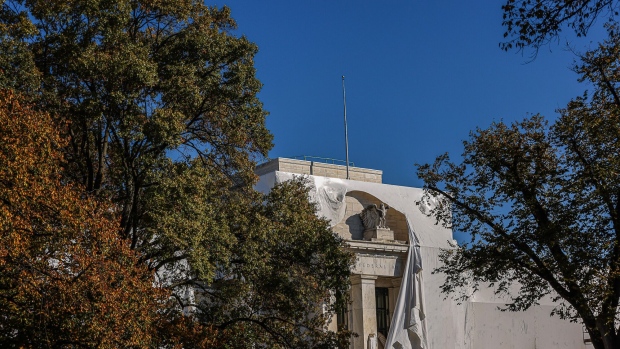Nov 6, 2023
Fed Says Tight Credit Standards, Weak Demand Persist at US Banks
, Bloomberg News

(Bloomberg) -- The Federal Reserve said US banks broadly reported tight lending standards and weak demand for loans in the third quarter, though both measures improved somewhat compared with the prior three-month period.
The proportion of US banks tightening standards on commercial and industrial loans for medium and large businesses fell to 33.9%, from 50.8% in the second quarter, according to a Fed survey of lending officers released Monday. Some 62.7% of banks are keeping lending conditions basically unchanged.
“They show improvement from the second quarter but it is true that the numbers are still pretty dire,” said Kenneth Kim, senior economist at KPMG LLP. “The net share of banks tightening standards — whether it’s for business loans, consumer loans or commercial real estate — those numbers are still very elevated even if they might be a touch lower than the second quarter.”
The collapse of four US regional banks earlier this year sparked turmoil in the financial sector and increased concerns that lenders would rein in access to credit in a way that could tip the US economy into a recession. Data since then have shown the economy remained resilient through the third quarter, bolstered by strong consumer spending.
Read more: Powell Hints Fed Is Done With Hikes in Pivot Cheered by Markets
The central bank has raised its benchmark rate by more than five percentage points since early last year to rein in price growth, but left it in a range of 5.25% to 5.5% last week, a second consecutive hold. Fed Chair Jerome Powell hinted the US central bank may now be finished with the most aggressive tightening cycle in four decades.
The survey showed an improvement in demand for credit, with the share of banks reporting weaker demand for commercial and industrial loans among large and mid-sized firms at 30.5%, down from 51.6% in the second quarter.
What Bloomberg Economics Says...
“The report showed one potential source of economic resilience waning: Consumer demand for credit and smaller firms’ demand for commercial and industrial loans continued deteriorating as interest rates rose throughout the third quarter. Demand for residential mortgages retreated as rates continued climbing. Demand for home equity lines of credit also retreated, weighing on our expectations for consumer spending on durables and home improvement.”
— Stuart Paul, US, Canada economist
To read the full note, click here
The Fed included some special questions in the survey on the likelihood of banks approving credit card and auto-loan applications by borrower FICO score. They found that significant net shares of banks were less likely to approve both types of loan applications from borrowers with FICO scores of 620.
“That’s a pretty big chunk of the US consumer that may have less credit available to them next year,” Kim said.
The figures in the survey, known as the Senior Loan Officer Opinion Survey, are calculated as net percentages, or the shares of banks reporting tighter conditions or stronger demand minus the proportion of banks reporting easier standards or weaker demand.
(Updates with comment from economist in third paragraph.)
©2023 Bloomberg L.P.


